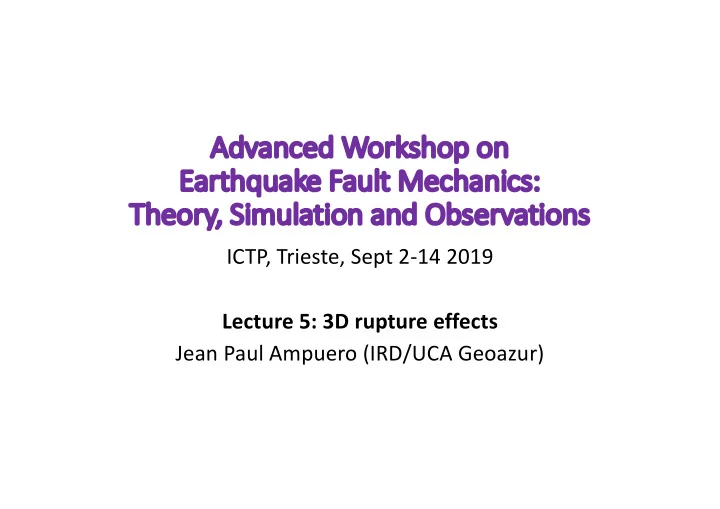

Adv Advanced anced Worksho shop p on n Ea Earthquake Fa Fault Mechanics: The Theory, , Simulation on and Observation ons ICTP, Trieste, Sept 2-14 2019 Lecture 5: 3D rupture effects Jean Paul Ampuero (IRD/UCA Geoazur)
Pulses on faults with finite seismogenic depth # ! ∝ # ! ∝ % $ ∝ # $ ∝ %
Arrest of long ruptures Runaway condition: Rupture ! " = $Δ& ' ( length/width > ! + ) + = )! + /$Δ& ' ( > ( Earthquake magnitude Rupture width Weng and Ampuero (2019)
Damage zone thickness saturates at large fault displacement Savage and Brodsky (2011) Mitchell and Faulkner (2009) < 1 #$ mature immature What limits the thickness of damage zones ? Ampuero and Mao (2017), Upper Limit on Damage Zone Thickness Controlled by Seismogenic Depth
Inner damage zone thickness depends on seismogenic width Inelastic strain Inelastic strain W=9 km W=12 km W=15 km
Fracture mechanics theory # Stress near crack tip: ! ≈ $ + ! & Map view: where ' is the stress intensity factor, '~ ) Δ! Δ! is stress drop and ) the shortest rupture size: ) = , (radius) for circular ruptures, ) = - (width) for elongated ruptures ( - ≪ / ) 3D view: Damage zone size: distance at which ! = ! 0 (stress=yield strength) Seismogenic 5 Δ! zone depth(W) 1 2 ∼ ) < ~0.01 - ! 0 − ! & Rupture length L>> W Relative stress drop
Seismogenic zone depth control on the likelihood of fault stepover jump
Examples of rupture complexity in large strike slip earth quakes Mw 8.6 Indian Ocean earthquake 20km Meng et. al 2012 Mw7.3 Landers Earthquake Sieh et. al 1993
Stepover jumps in past earthquakes • Surface fault traces of 22 continental strike slip faults are studied • 2/3 of the rupture end points are associated with stepover or fault trace termini.(Wesnousky 2006) • Rupture rarely jump through stepovers wider than 5km. And below this limit ,stepover only stop 40% of the total events. (Wesnousky 2006)
Critical stepover distance ≈ 5 km Observations Simulations Shaw and Dieterich (2009) (Wesnousky 2006)
Critical stepover distance from static stress analysis K s = S q + s + II ( ) O ( r ) ij ij 0 p 2 r µ × D s K W r -1/2 II prestress 2 æ ö stressdrop D s ç ÷ µ H W ç ÷ c s - s è ø yield 0 Critical stepover distance proportional to seismogenic depth Bai and Ampuero (2017)
Dynamic rupture simulation Evolution of the rupture front Bai and Ampuero (2017)
Relative stress ratio: ! = ($ % − $ ' )/($ ' − $ * ) = (strength excess) / (stress drop) High S = low initial stress
Bai and Ampuero (2017) ! = ($ % − $ ' )/($ ' − $ * ) Dilatational stepovers Compressional stepovers ß Critical initial stress
Bai and Ampuero (2017) ! = ($ % − $ ' )/($ ' − $ * ) Dilatational stepovers Compressional stepovers ß Critical initial stress
Bai and Ampuero (2017) Compressional stepovers Dilatational stepovers Critical stepover distance ! = ($ % − $ ' )/($ ' − $ * ) ! = ($ % − $ ' )/($ ' − $ * ) ß Initial stress ß Initial stress
Summary Effects of seismogenic width W: • Pulse-like rupture • Changes the energy balance: limits the energy flux, introduces rupture inertia à implications on rupture arrest size • Limits the thickness of damage zones • Limits the stepover distance that ruptures can jump • Allows for rupture at “unstable” and “forbidden” speeds
Recommend
More recommend